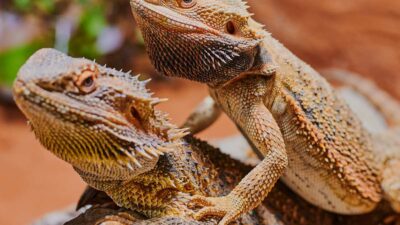Why do bearded dragons bob their heads? This seemingly peculiar behavior has intrigued reptile enthusiasts and pet owners alike for generations. As one of the distinctive characteristics of these captivating creatures, the rhythmic head-bobbing of bearded dragons sparks curiosity and prompts questions about its underlying reasons.
Bearded dragons bob their heads as a way of communicating various messages to other dragons or to their environment. This behavior can signify dominance, particularly in males establishing their territory or asserting their status within a group.
During the breeding season, head-bobbing serves as part of a courtship display, indicating readiness to mate. Additionally, bearded dragons may bob their heads in response to changes in their surroundings, such as the presence of unfamiliar objects or individuals.
Why do bearded dragons bob their heads? – 15 Reasons

Bearded dragons bob their heads for a variety of reasons, mainly as a form of communication and behavior display. Here are some explanations:
- Communication: Head bobbing can be a form of communication between bearded dragons, signaling dominance, submission, or mating readiness.
- Territorial Displays: Male bearded dragons may bob their heads to establish territory or dominance, especially when housed together.
- Mating Rituals: Male bearded dragons often bob their heads as part of their mating rituals to attract females.
- Aggression: Head bobbing can also be a sign of aggression, especially if accompanied by other aggressive behaviors such as puffing up or hissing.
- Warning Sign: In some cases, head bobbing can serve as a warning sign to other dragons or perceived threats.
- Environmental Stimuli: Changes in their environment, such as the presence of other animals or sudden movements, can trigger head bobbing as a response.
- Social Hierarchy: Within a group of bearded dragons, head bobbing can establish or reinforce social hierarchy.
- Excitement: Bearded dragons may bob their heads when they’re excited, such as during feeding time or when exploring new surroundings.
- Hormonal Changes: Fluctuations in hormone levels, particularly during breeding season, can lead to increased head bobbing behavior.
- Courtship: During courtship, both male and female bearded dragons may engage in head bobbing as part of their mating dance.
- Submission: Subordinate dragons may bob their heads as a sign of submission to more dominant individuals.
- Curiosity: Bearded dragons are naturally curious creatures, and they may bob their heads when investigating new objects or stimuli in their environment.
- Temperature Regulation: Head bobbing can help regulate body temperature by increasing airflow around the head and neck region.
- Stress Relief: Some bearded dragons may head bob as a way to relieve stress or tension, similar to how humans might fidget or pace.
- Bonding: When kept as pets, bearded dragons may head bob in response to their owners as a form of bonding or recognition.
Differentiating normal head bobbing from abnormal behavior
Differentiating normal head bobbing from abnormal behavior in bearded dragons involves observing the frequency, intensity, and context of the behavior. Here’s a guide to help distinguish between the two:
- Normal Head Bobbing:
- Occasional head bobbing during social interactions, especially during mating rituals or when establishing dominance.
- The head bobbing is rhythmic and consistent, often accompanied by other typical behaviors like arm waving or color changes.
- It occurs in response to specific stimuli such as the presence of other dragons, changes in environment, or during feeding time.
- The bearded dragon appears otherwise healthy, with normal appetite, activity levels, and body condition.
- Abnormal Behavior:
- Excessive or persistent head bobbing that occurs frequently throughout the day without an obvious trigger or context.
- Rapid or erratic head bobbing that seems uncoordinated or out of sync with normal behavior.
- Head bobbing accompanied by other signs of stress or illness, such as lethargy, loss of appetite, weight loss, or abnormal posture.
- Aggressive head bobbing directed towards inanimate objects, reflections, or even the owner, especially if it’s out of character for the dragon.
- Head bobbing in isolation, without any other typical behaviors associated with social interaction or communication.
If you observe abnormal head bobbing behavior in your bearded dragon, it’s essential to monitor their overall health and behavior closely. Consider factors such as environmental conditions, diet, housing setup, and recent changes that could be contributing to stress or discomfort.
Also, if you’re concerned about your dragon’s behavior, consulting a reptile veterinarian experienced with bearded dragons is advisable to rule out any underlying health issues and provide appropriate care.


